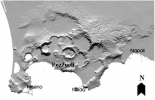Thank you Frank Petrexa and Loxuru.
Vesuvius has a very particular periodicity, it remains active with the crater conduit open for about 300 years, then, with the crater conduit blocked it remains inactive for about 1000 years, it enters into activity with a Plinian explosion, creating real disasters.
We could think that now Vesuvius will remain silent for another 900 years ... The last eruption, terminal, was that of 1945, and the conduit has closed. It opened in 1630 with an explosion similar to that of 79 AD and was active with various flows for the next 300 years, exactly as it had been until about 500 AD, for about 300 years after the Pompeii event.
The real danger, perhaps even imminent, is represented by the caldera below Pozzuoli, where the Solfatara, that is the Phlegraean Fields, is always active. The whole area is constantly affected by the phenomenon of bradyseism, that is the raising and lowering of the land, as it was in the 1980s, with an elevation of the land of about 2 meters. The resulting eruption would have the characteristics of the one that affected Yellowstone. If you look at the maps you can easily understand that the Gulf of Naples is nothing more than the edge of an immense crater.













